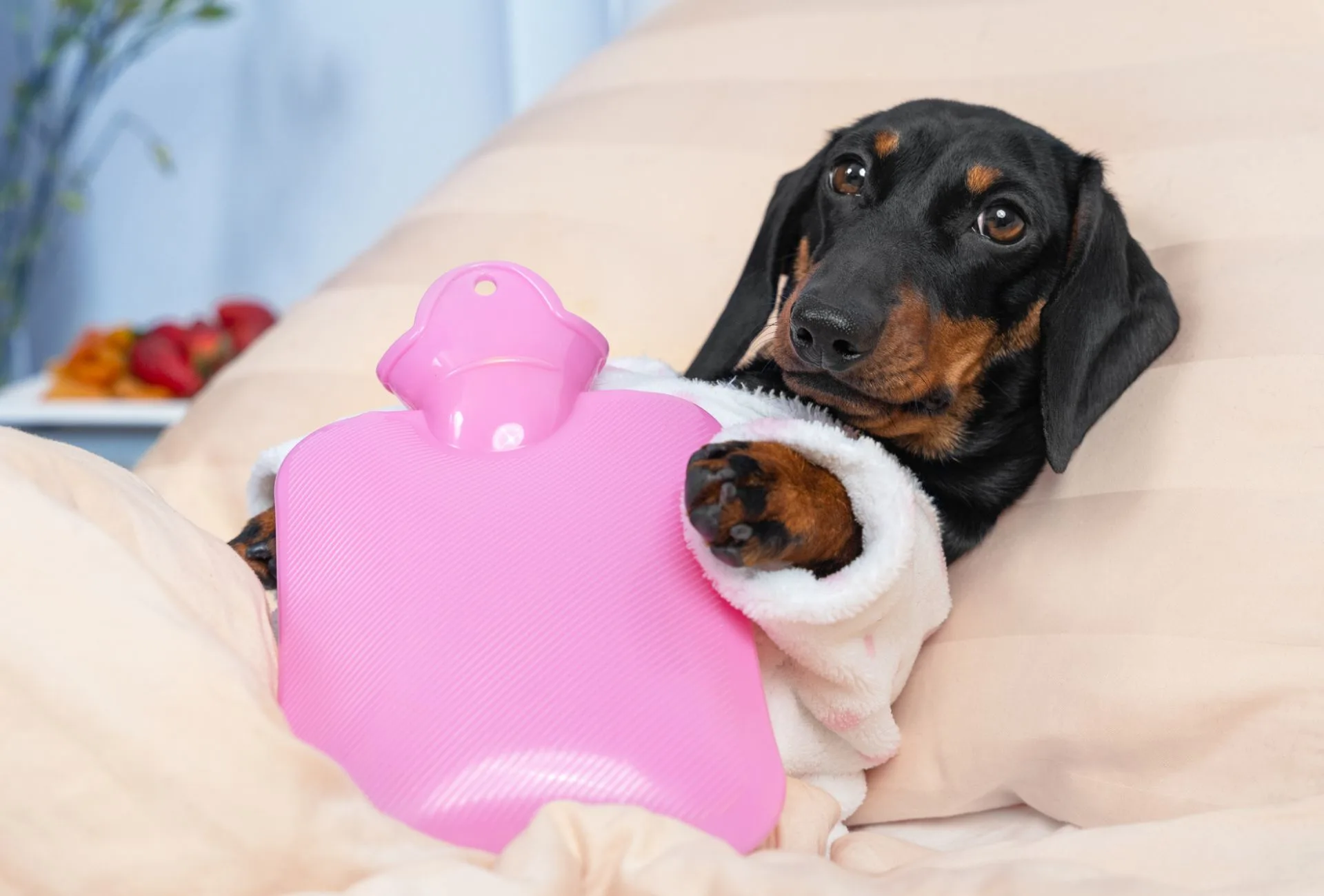Period cramps are well known among women, often accompanied by mood swings, discomfort, and general unease.
Since dogs also go into heat it is not farfetched to believe that they also experience their version of period cramps during their heat cycle.
The canine heat cycle, also known as estrus, is a natural biological process that every unspayed female dog goes through.
It’s a crucial part of the reproductive cycle that comes with its own set of challenges and unwelcome side effects including discomfort and period cramps.
By understanding and addressing this part of your dog’s well-being, you can ensure a happier and more comfortable experience during her heat cycle.
In this blog post, we will dive into the world of dog period cramps and most importantly effective ways to alleviate your dog’s discomfort.

Recognizing Period Cramps in Your Dog
Unlike women, dogs don’t menstruate, instead, they go through estrus that can last anywhere from 7-21 days.
This cycle typically occurs every six to eight months and your dog will get her first heat at around 18-24 months of age, depending on the breed.
During this time, your dog’s body undergoes significant hormonal changes as it prepares for a potential pregnancy.
These hormones can cause fatigue, pain, irritability, fear, decreased appetite, and other signs in your dog.
Bleeding also varies from dog to dog, while some bleed heavily others only lose a few drops.
While dogs cannot express their discomfort through words, their behavior often speaks volumes.
As responsible dog owners, it is essential to recognize signs of distress or pain in our dogs and take proactive steps to provide them with relief.
If you notice any of the following signs during your dog’s heat, she might be suffering from period cramps or period-related pains and aches.
- Restlessness, pacing
- Decreased appetite
- Excessive panting
- Vocalization (whining, whimpering, barking)
- Altered posture (arched back or hunched position)
- Excessive licking or chewing
- Lethargy
- Irritability or aggressive behaviors
- Vomiting or diarrhea
Keep in mind that these symptoms can also be signs of various other diseases and it’s always important to rule out other underlying conditions.
8 Effective Ways to Relieve Dog Period Cramps
There are many different ways to relieve pain and discomfort during your dog’s heat.
From the therapeutic benefits of massages and the warmth of heat pads to the significance of proper hydration, restful periods, tailored exercise, and the use of medication, each approach can play a significant role in addressing and alleviating period cramps.
Since every dog is different, not all approaches will work and your dog may not be comfortable with some.
Just try them and see how your dog reacts and note what ways seem to be working better to release pain and cramping.
1. Massages
A soothing massage can work wonders for your dog’s discomfort.
Simply being at her side and providing gentle pets and touch can help with easing anxiety.
If your dog is comfortable with it, try gently stroking her belly in a circular motion to help relax tense muscles and promote better blood circulation.
Your touch isn’t just physical, it’s a love language that many dogs appreciate and communicates your care and support.
2. Heat Pad
Heat is widely used in pain treatment and is a very effective method to relieve it.
When heat is applied to the skin, blood flow is increased to this particular area of the body.
With increased blood flow, oxygen and nutrients come along which help speed up the healing process.
It also relaxes muscles and has an analgesic effect (changes the perception of pain) which makes it perfect as a period cramp remedy.
Heat and warmth also have a soothing effect similar to the feeling you get when you snuggle up in a cozy blanket on a chilly day.
A warm, not hot, heat pad placed beneath your dog’s bedding can provide much-needed comfort.
The gentle warmth can ease cramps and create a comfortable environment for your dog to rest and recover.
There are heat pads specifically made for dogs that you can check out but you can also opt for a normal heat pad that is wrapped in a cover.
Placing it beside your dog’s bed can give her the option to lie somewhere else when she gets too warm or uncomfortable.

3. Hydration
Hydration is a fundamental part of your body’s well-being and is often overlooked or forgotten.
During heat, your dog is more likely to become dehydrated so make sure that fresh and clean water is readily available for her at all times.
Proper hydration can ease menstrual cramps, improve digestion, and reduce bloating and fatigue.
If your dog is a bad drinker (mine definitely is) then check out this article on 14 Simple Tricks to Get Your Dog to Drink More Water.
Also, consider feeding your dog hydrating snacks such as watermelon, strawberry, and cucumber.
4. Rest
Rest is necessary for our bodies to recover strength and health.
Sometimes simply lying down and having a nap can boost your overall well-being and the same is true for our dogs.
Whatever your dog is dealing with, whether that’s period cramps or injuries, rest allows the body to work its healing powers.
Ensure your dog has a peaceful, comfortable spot to curl up and relax.
A restful slumber not only promotes physical recovery but also supports emotional well-being.
If your dog seems to be feeling down and not as energetic, allow her body the time to rest and revitalize.
5. Exercise
On the other hand, it’s important that your pet is getting enough movement throughout her day.
Exercise is an amazing way to reduce muscle tension, stiffness, and release endorphins.
Since she is on her heat, opt for low-impact activities like leisurely walks or mild playtime.
Be attuned to your dog’s cues and opt for activities that provide relief without straining her.
When outside, make sure to always leash your dog to avoid an unwanted pregnancy.
6. Medication
If your dog’s discomfort seems severe, consulting a veterinarian is a responsible choice.
Non-steroidal anti-inflammatory drugs (NSAIDs) are commonly prescribed to reduce pain and inflammation in dogs.
Your vet can provide you with some safe pain relief options such as Rimadyl and Metacam.
Never give your dog over-the-counter medicine like Ibuprofen or Tylenol.
7. Supplements
Beyond the traditional methods of relief, certain supplements can offer valuable support in alleviating dog period cramps.
Before introducing any supplements, however, it’s crucial to consult your veterinarian to ensure they are safe and suitable for your dog’s specific needs.
Omega 3 and 6 fatty acids help reduce inflammation and may help tackle period pain.
Some dog owners have reported positive effects of CBD oil in managing pain and promoting relaxation.
Although the few studies that have been done on dogs using CBD look promising, many CBD products are untested and unregulated so always consult with a vet before using CBD products.
Turmeric and ginger have anti-inflammatory properties that could potentially provide relief from discomfort and support digestion.
Remember, while these supplements may offer potential benefits, their effectiveness can vary from dog to dog.
8. Diet
A healthy diet is a cornerstone of your dog’s well-being, regardless of her heat cycle.
However, there are some things you can add or change in your dog’s diet to promote well-being during estrus.
Instead of supplements, consider feeding your dog foods high in omega fatty acids such as salmon, tuna, and flaxseed oil.
Also up the magnesium and calcium in your dog’s diet by adding almonds, peanut butter, and yogurt.
If your dog is struggling with an upset stomach, consider dividing your dog’s daily food intake into multiple smaller meals.
Disclaimer: This blog post does not substitute veterinary attention and does not intend to do so. I am not a veterinarian or pet nutritionist. If your dog shows any sign of illness, call your vet.